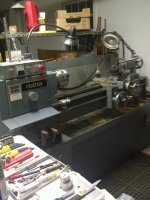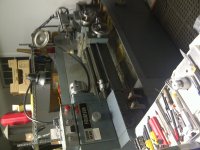All of the older style south bend lathes had "auto style crank shaft bearings" in the head stock. Very seldom will you find an old south bend lathe so worn out that it will not do good gun work. This includes chamber work. The quality of work these old machines produce depend on the human factor!
True, both incorporate the concept of Plain Bearings, but it ends there.
Internal combustion engines have bearings that consist of multiple layers, a very strong steel backing with a plating such as copper, followed by en extremely thin layer of soft material, (Babbit), that rides against the bearing journal.
This principle requires a high pressure oiling system, which induces a thin film of oil between the mating parts. In short, when all is going well, the parts rarely touch in normal operation, as the oil film "wedges" between the parts.
In a lathe spindle such as incorporated in the South Bends, the bearings are a bronze alloy, with a non pressurized oiling system where the oil is constantly smeared on the parts.
Plain bearings work best in low RPM high load applications, where ball or roller bearings are best in a higher speed application. That is, if there is not a pressurized oiling system. A pressurized oiling system changes everything. A plain bearing with a true pressurized oiling system will take higher static and medium RPM loads. But, the oiling system must be present at all times.
One of the most remarkable applications of this principle is the huge Mount Polamar 200 inch Reflector Telescope. The main "shoe" that supports the massive 500 ton structure is a huge half moon that is babbited, with a constant oil pressure. The system is so friction free that the entire thing is powered by a motor that produces about 1/12 horsepower.
http://adsabs.harvard.edu/full/1948PASP...60..225R
South Bend Lathe Spindles are fine as long as they have oil. Even though it is non pressurized, the oiling wicks do a adequate job of supplying the plain spindle bearings at the speeds and loads encountered in normal use.
This is proved by the fact that multitudes of these small lathes are still giving good service, even though they could be twice as old as their owner.



